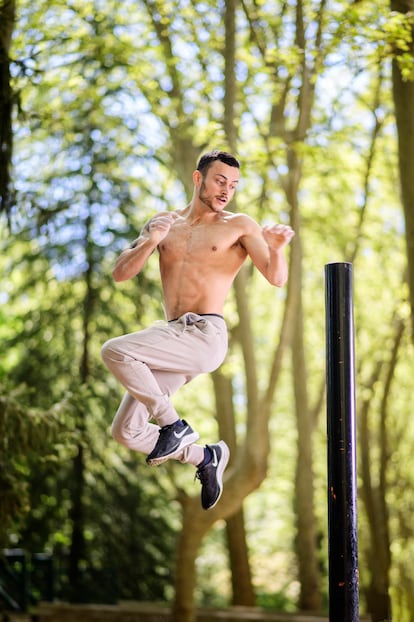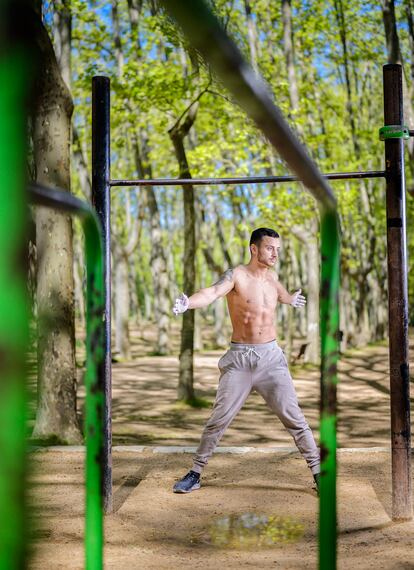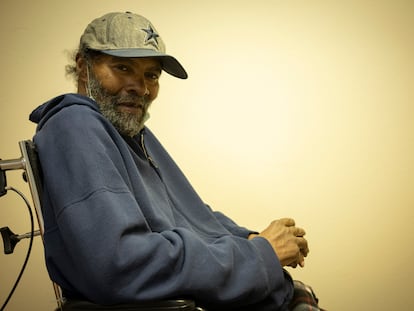Roger Jiménez, the Catalan king of calisthenics
The former climber was mesmerized by four guys working out in the street. It wasn’t long before he was testing himself against the best and becoming the world champion of the sport
Roger Jiménez generally wakes up at 6am, but not today. He is back home on vacation and can afford to get up at 8am. Two hours later he appears smiling against a purple backdrop on the screen of our Zoom call. He has a couple of days left before returning to Dubai, where he has lived for the past five years. He’s finishing packing and saying goodbye to his family and friends and he’s also saying goodbye to the Catalan scenery. He says that’s what he misses the most. There is nothing green in Dubai. The emirate bears no resemblance to his native Santa Coloma de Farners, the mountain-framed village in the Catalan province of Girona where he was born 23 years ago. It was here that he first practiced on the bars used in calisthenics, the sport that took him to the United Arab Emirates and made him a world champion.

When he started training in 2014, nobody was talking about calisthenics. The discipline was referred to as a “street workout,” an activity that originated in public spaces, open to anyone who could not afford a gym. Its scope is such that Jiménez finds it difficult to define: “Strength and dexterity exercises using one’s own body weight,” he says finally. It ranges from tiger bend push-ups and single finger pullups to somersaults that turn into a dance with the bars. It is a bonafide spectacle; at least one that Jiménez fell in love with as soon as he saw it. He was strolling through the park in his home town when he saw four guys – now his friends – practicing. He went on Facebook and messaged them: “I’ve seen you guys and I flipped out watching what you do. I want to join you,” he wrote. They gave him schedules and some basic notions, and he was off: there were training sessions every week, meets and “mini-competitions” with athletes from other towns that boosted his motivation and led to a further exchange of tips and advice.
The turning point was a competition in Empuriabrava, Girona, in 2015. It was attended by the best calisthenics athletes in the region, including the second top calisthenics athlete in Spain. Even so, Jiménez won. When he got home, he went straight to his father. “In two weeks, there is an international meet in Madrid and I think I can win,” he told him. His father didn’t miss a beat. “Let’s go!” he said. And they set off for the Spanish capital. Winning there paved the way for the Super Final in Russia. In less than a year, Jiménez went from watching calisthenics athletes online to rubbing shoulders with them. “Competing against your idols; it’s a dream, isn’t it?” he says. Coming in 11th among the 21 athletes in Russia motivated him further. His nerves had worked against him, but he proved he had unique tricks that helped him stand out.

His exponential success is no coincidence. When he started to get involved in calisthenics, he was already in the perfect physical shape for it. He had just taken a break after eight years immersed in climbing. “My thing has always been the upper body,” he says. “I like individual and strength sports.” His father has been teaching taekwondo for 20 years at the local gym, although he also runs his own company, and his uncle is the professional climber Ramón Julián Puigblanqué, twice world champion and three-times European champion; winning world titles runs in the family. This uncle – his mother’s brother – is the person who got Jiménez into climbing, taking him to climbing walls on weekends. Jiménez liked it and when he was eight, he entered his first competition.
By the age of 15, however, he’d had enough. He had started competing abroad and the demands of the sport had become too much. He was, after all, barely more than a child. “I was burned out. I quit and said: ‘I don’t want to climb anymore, I want to do something else. I don’t have time for myself, for my friends, for school.’ It was just climbing, climbing, climbing. I liked it and I still like it, but it wasn’t a passion. I hadn’t chosen it 100%.” He still has the climbing wall in his garage that his father set up for him there, a vertical façade of colored footholds that reaches the roof, but which no one uses anymore. Not him, nor his parents or sister.

Then came the calisthenics bar that was installed in the garden over a couple of mattresses. And Jiménez’s life became calisthenics, calisthenics, calisthenics. He can’t even talk about anything other than street workout. Apart from sport in general, of course.
If he hadn’t come across those four guys that day, he would probably have continued his trajectory in computer science. For a while, he did continue to study, making sure he had time to train by getting up at 6am. The afternoons were devoted to study and the rest of the training was done at night.
Climbing not only gave him his physical fitness, it also gave him absolute self-discipline, with hard work and perseverance being essential to success. When he finished his computer science degree, his body was demanding more calisthenics. It was all he could think about. The workouts ate up his day. He trained, ate, trained and slept. The shows he did from time to time with colleagues from Lloret de Mar earned him a bit of cash, enough to pay for gas. “Study! Calisthenics won’t put food on the table,” he was told at home. But he only paid so much attention, determined as he was to go far with the bar. His ambition sounded familiar. “Like with the climbing, you’ll become a champion and then you’ll quit,” his father would say with a chuckle.
When Jiménez qualified again for the Super Final in Russia in 2016, he came in fourth. “I thought, holy shit, there’s not far to go from fourth to first,” he says. That was July and he returned home to intense training while also starting to train the people around him; a neighbor and a couple of friends. In September, Gravity Calisthenics Gym, the Dubai calisthenics gym that recruits the best athletes in the world, contacted him on Instagram to offer him a job as a personal trainer. They wanted him there within two weeks. He had only just turned 19, and the distance and language barrier made him hesitate. In fact, it was his family that gave him the push he needed to say yes. By his second week in Dubai, he was already teaching class without assistance. The support of his classmates and a British girlfriend helped him to overcome the language barrier. The rest was a piece of cake. Living there means devoting himself to what he is passionate about, preparing for competitions and training his clients, whose progress also motivates him.
Winning the Battle of the Bars – the largest premier federation competition in calisthenics – paved the way for him to compete for the World Championships in 2018. His opponent took the title, but the judges’ decision was controversial; the competition was believed to have been rigged. A rematch was arranged for the following year. “Two days earlier, the guy [who supposedly won] sent a message saying he had fallen off the bike.” It was a lie. He was disqualified and, in his place, they selected Thomas Kurganov, the best athlete in the world, who would compete against Jiménez.

This time Jiménez nailed the World Champion title and was able to step onto the lightweight podium – for competitors weighing between 60 and 65 kilograms. The golden belt trophy has since lain on a table in his room in Santa Coloma de Farners, where cups from his climbing days line up along with those from calisthenics.
The term calisthenics comes from the Greek “kalos” (beauty) and “sthenos” (strength). The beauty of strength; of movement. Chances are, Jiménez’s rivals can match him in terms of strength. What makes him stand out is his style. People recognize him from the way he moves. In calisthenics, each athlete creates his own movements and combinations, developing a unique relationship with the bar. Jiménez’s is defined by two words: clean and flow. He has good flow. “They say that the way I move is very clean,” he adds. “I am mostly known for my freestyle, the dynamic [moves], the flips, and combos.” That’s what sets him apart. That, and constant innovation.
His only plans for the future involve training and practicing, though he does admit to having fantasized about returning to Girona and setting up his own gym. He estimates that he has three or four more years left in Dubai. The pandemic prevented him from renewing his title in 2020. So he continues to train while posting videos of his moves on social networks, hoping that this year he can win the coveted golden belt again.
English version by Heather Galloway.


